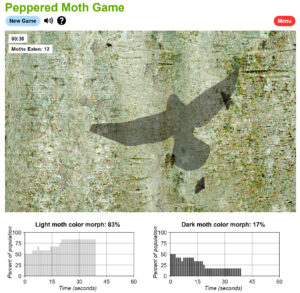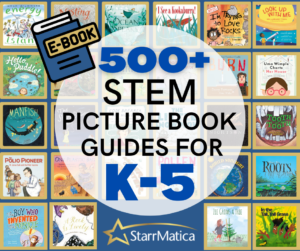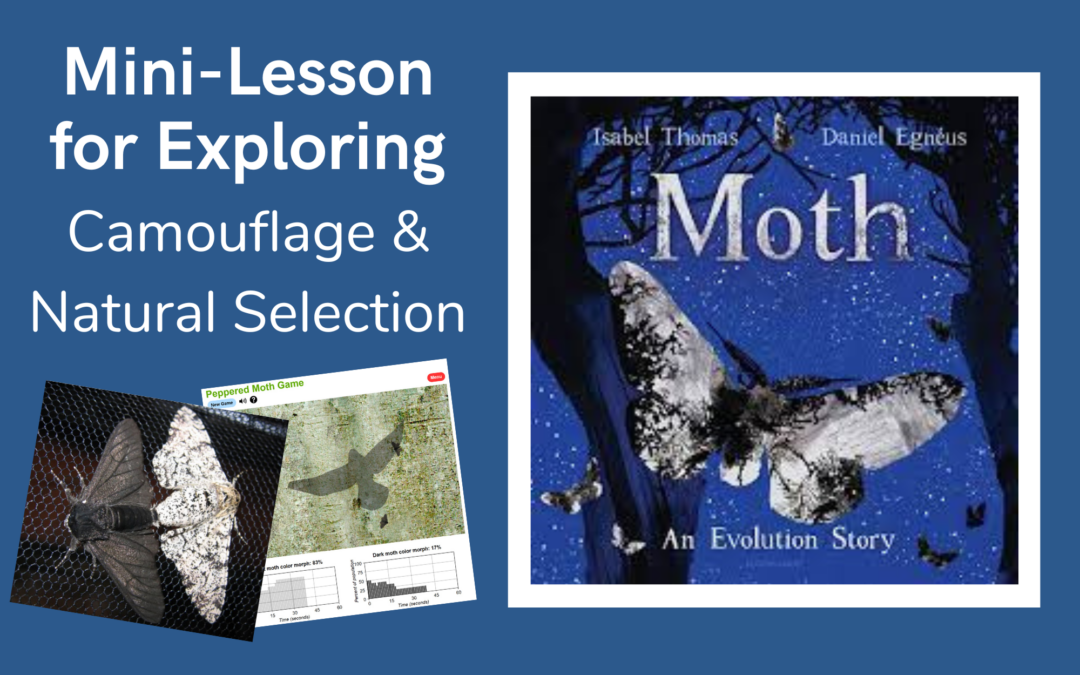This summer, I’ve been planning a little bit of time each day to help my boys practice “thinking scientifically.” I’ve shared some of the activities we’ve been doing on StarrMatica’s Facebook page, and I’ll continue to share ideas with you throughout the summer. I know official “science time” in the classroom is often limited, so my intention is for you discover some new ideas for helping your students to view the world like scientists in small ways through “mini-lessons” as well as integrated into your daily schedule.
Often, activities with my boys are inspired by a picture book I have read. I’ve read HUNDREDS of science-themed picture books throughout the last year, so my “mental bookshelf” is full of amazing texts! This week I was inspired by the book: “Moth: An Evolution Story by Isabel Thomas.” Isabel tells the story of one of the most famous examples of natural selection as proven by Bernard Kettlewell’s experiments.
Rather than beginning by reading the book, which I know is often our default lesson structure, I began with a photograph to engage my boys with the phenomenon of the peppered moth displaying two different colors. Even short mini-lessons should be structured so that the students are figuring something out. Beginning with a phenomenon facilitates this by prompting students to activate their prior background knowledge and to generate questions about what they are observing.
This is the photo I showed them: https://www.snexplores.org/article/how-moth-went-dark-side
And I simply asked: What do you notice? What do you wonder? This is where a lot of science curriculums miss the mark. They begin the lesson with a phenomenon, yet then they tell the students what they should be noticing and wondering or what question they should go on to investigate. By keeping your questions general, you allow room for students’ questions to drive your next steps.
My second grader wondered what kind of insect it was and if it was the same kind of moth or two different kinds because they were different colors.
My kindergartener wondered if it was two moths or one moth joined together (because of the way the moths are positioned in this photograph). He also wondered why the same kind of moth was two different colors.
Once we had determined together that it was probably two moths, I questioned them about whether they thought the moths were the same species or a different species and to argue their point using evidence from the photograph. They thought was probably the same species because of the similar head, body, and wing shape. Then we decided together to investigate why they were different colors.
This is another critical transition in the lesson. While it may be tempting to jump in and show a video or read a book to help them answer the question, students need the opportunity to make sense of the phenomenon themselves. For this particular lesson, I had the boys engage  with this peppered moth simulation: https://askabiologist.asu.edu/peppered-moths-game/play.html
with this peppered moth simulation: https://askabiologist.asu.edu/peppered-moths-game/play.html
Before we began the simulation, I explained that they were going to play the role of birds that are peppered moth predators. I asked them why they thought they had the choice between a light forest and a dark forest for the simulation. Because we have read so many science picture books over the years, they predicted that the forest selection had to do with how well the different colored moths would be camouflaged and predicted that in the light forest, the birds could see the dark moths better so they would eat more and vice versa in the dark forest. Honestly, they came up with all of those predictions on their own because they have a lot of prior science knowledge. With students who don’t have as much previous science experience, you can use talk moves to help students build on one another’s ideas about connections between the moths and the forest colors using the students’ related experiences.
The boys went on to test their theories of camouflage using the simulation, and we had a rich discussion about the data the simulation displayed and what it meant.
It was only then that I read the Moth picture book to give context to why some forests were light and some were dark and how natural selection determined how many light and dark moths were observed in each location over time.
selection determined how many light and dark moths were observed in each location over time.
While reading the text we talked about what patterns they noticed and how they knew they were patterns. We talked about the causes and effects related to pollution and the moth population. We talked about stability and change, time scales, and how the simulation modeled the different ecosystems.
I stopped before the end of the text and asked them to predict what they thought would happen to the moth population if the forests started to become less polluted based on their prior knowledge and evidence from the text. How long would this change take, and why did they chose that amount of time? What additional information would they need to make a more accurate time prediction?
Teaching science can feel overwhelming if we think every lesson needs to be an in-depth unit with a storyline where students design their own investigations. Yet, during this phenomenon-based “mini-lesson” the boys were still using the science and engineering practices of: asking questions, gathering and analyzing data, using mathematics and computational thinking, engaging in argument from evidence, and constructing explanations. And they were examining the phenomenon through the crosscutting concept lenses of cause and effect, patterns, stability and change, and systems and system models because of the questions we discussed.
The key to making sure these mini-lessons are effective lies in the way you structure the lesson for students to make sense of the phenomenon with you guiding their efforts by asking productive questions and facilitating their discussion and exploration. Double check your plan to be sure you aren’t front loading the lesson with content or answering their questions for them or reading the text too early if it provides the information they are supposed to be figuring out on their own through an experience you provide.
And finally, here are a couple of NGSS performance expectations that connect well with this mini-lesson:
K-ESS3-3 Communicate solutions that will reduce the impact of humans on the land, water, air, and/or other living things in the local environment.
3-LS3-1 Analyze and interpret data to provide evidence that plants and animals have traits inherited from parents and that variation of these traits exists in a group of similar organisms.
3-LS3-2 Use evidence to support the explanation that traits can be influenced by the environment.
3-LS4-2 Use evidence to construct an explanation for how the variations in characteristics among individuals of the same species may provide advantages in surviving, finding mates, and reproducing.
If you are looking for additional science texts, check out StarrMatica Texts: Science Your Way, our library of K-5 science informational texts that can be customized to meet specific Common Core ELA standards. Each 1st – 5th grade text has multiple reading levels so all of your students can read the same content independently.
Not a subscriber? Click here for a free trial to access our entire library of texts.
And if you are looking for additional picture books for your science classroom, check out the Perfect Picture Book Pairing Series that includes one-page guides with activities and discussion questions for hundreds of STEM-themed picture books aligned to every NGSS performance expectation!
CLICK HERE TO PREVIEW THE PERFECT PICTURE BOOK PAIRING EBOOKS

